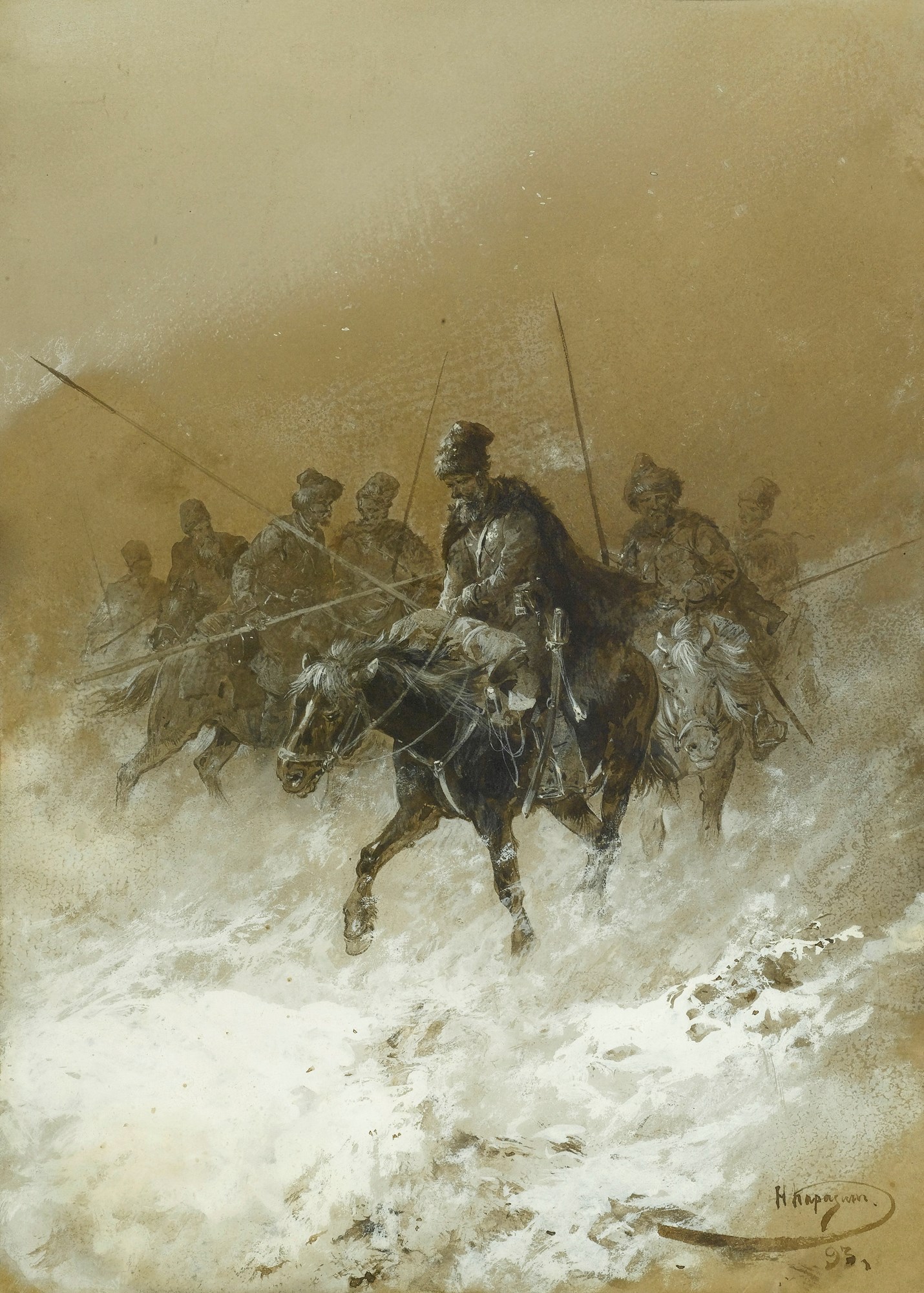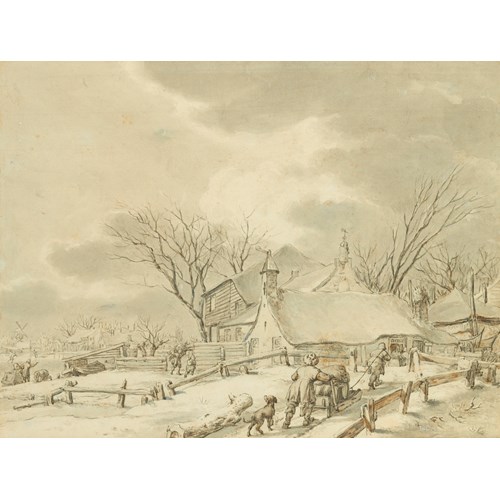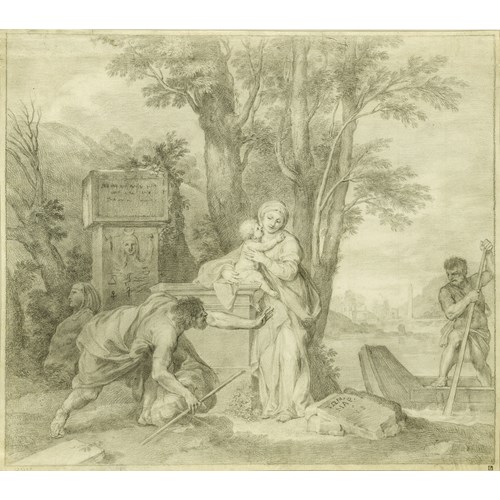Marketplace
Cavalry in the 1812 Campaign
Nikolai Nikolaevich Karazin
Cavalry in the 1812 Campaign
Date 1893
Epoque 1850-1900, 19th century
Origine Ukraine, Russia
Medium Pen, Ink, Gouache on paper laid on card
Dimension 31.25 x 22.75 cm (12¹/₄ x 9 inches)
In Cavalry in the 1812 Campaign, Nikolai Nikolaevich Karazin depicts Cossack soldiers charging through a harsh winter landscape on horseback. Icy winds whip powdered snow around the figures and their mounts and the thick-fleeced garments that the soldiers wear seem to offer insufficient protection against the elements. The men are all prepared for battle and wield lances, but they must also combat these horrific conditions. Nevertheless Karazin has depicted a fearsome sight, as these warriors emerge at a pace from the gloom of the snow storm.
Karazin depicts a scene from Napoleon’s (1769-1821) invasion of Russia in 1812. The campaign, especially the retreat from Moscow, had a disastrous effect on Napoleon’s army and it has had a sustained role in Russian culture, resulting in Leo Tolstoy’s (1828-1910) War and Peace and Pyotr Ilyich Tchaikovsky’s (1840-1923) 1812 Overture. Karazin portrays the allied retreat when Napoleon’s army suffered from horrendous hunger, a harsh winter and their enemy’s partisan tactics. Light Russian cavalry, including mounted Cossacks like those shown here, repeatedly assaulted and broke up isolated French units.
Karazin studied the harshness of the Russian winter a number of times in his work, an example being Collecting Brushwood in Winter. As in the present work, Karazin has used a muted, almost monochrome palette which emphasises the pure white of the snow. As the snow is freezing to the Cossacks’ beards and clothing, so in this work the bare tress are coated in frost. A white haze suggests that there is a strong and bitter wind howling through the scene: this technique is also deployed in Cavalry in the 1812 Campaign.
Karazin was born into a family of enlightenment scientists, but rather than follow in his father’s footsteps, he joined the army, graduating from the Moscow cadet school at the age of twenty and serving as a dragoon officer. Three years later, however, he pursued his passion for art by studying at the Imperial Academy of Art in St. Petersburg.
As a military officer, Karazin participated in the campaign against the January uprising in Poland (1864) and military campaigns in Turkestan (1864-1870). He retired from active service in 1871, although he continued to work as a military correspondent and illustrator. He was awarded the Order of St. Vladimir and a gold sword in recognition of his military service. This military lifestyle had a profound impact on Karazin’s painting. The present work is typical in that he often depicted Russian military successes, another example being Russian Troops Taking Samarkand in 1868. Although a very different work to Cavalry in the 1812 Campaign, it shows a similar interest in depicting the Russian military as well as a brilliant talent for conveying atmosphere, which in this case is oppressively hot and dusty as opposed to the bitter chill of the present work.
Later in life, Karazin was known principally as a painter, illustrator and designer of postcards and in 1904, four years before his death, he became an Academician at the Imperial Academy of Arts.
Karazin depicts a scene from Napoleon’s (1769-1821) invasion of Russia in 1812. The campaign, especially the retreat from Moscow, had a disastrous effect on Napoleon’s army and it has had a sustained role in Russian culture, resulting in Leo Tolstoy’s (1828-1910) War and Peace and Pyotr Ilyich Tchaikovsky’s (1840-1923) 1812 Overture. Karazin portrays the allied retreat when Napoleon’s army suffered from horrendous hunger, a harsh winter and their enemy’s partisan tactics. Light Russian cavalry, including mounted Cossacks like those shown here, repeatedly assaulted and broke up isolated French units.
Karazin studied the harshness of the Russian winter a number of times in his work, an example being Collecting Brushwood in Winter. As in the present work, Karazin has used a muted, almost monochrome palette which emphasises the pure white of the snow. As the snow is freezing to the Cossacks’ beards and clothing, so in this work the bare tress are coated in frost. A white haze suggests that there is a strong and bitter wind howling through the scene: this technique is also deployed in Cavalry in the 1812 Campaign.
Karazin was born into a family of enlightenment scientists, but rather than follow in his father’s footsteps, he joined the army, graduating from the Moscow cadet school at the age of twenty and serving as a dragoon officer. Three years later, however, he pursued his passion for art by studying at the Imperial Academy of Art in St. Petersburg.
As a military officer, Karazin participated in the campaign against the January uprising in Poland (1864) and military campaigns in Turkestan (1864-1870). He retired from active service in 1871, although he continued to work as a military correspondent and illustrator. He was awarded the Order of St. Vladimir and a gold sword in recognition of his military service. This military lifestyle had a profound impact on Karazin’s painting. The present work is typical in that he often depicted Russian military successes, another example being Russian Troops Taking Samarkand in 1868. Although a very different work to Cavalry in the 1812 Campaign, it shows a similar interest in depicting the Russian military as well as a brilliant talent for conveying atmosphere, which in this case is oppressively hot and dusty as opposed to the bitter chill of the present work.
Later in life, Karazin was known principally as a painter, illustrator and designer of postcards and in 1904, four years before his death, he became an Academician at the Imperial Academy of Arts.
Date: 1893
Epoque: 1850-1900, 19th century
Origine: Ukraine, Russia
Medium: Pen, Ink, Gouache on paper laid on card
Signature: Signed in Cyrillic (lower right) and dated ‘93’, further inscribed on reverse.
Dimension: 31.25 x 22.75 cm (12¹/₄ x 9 inches)
Plus d'œuvres d'art de la Galerie









